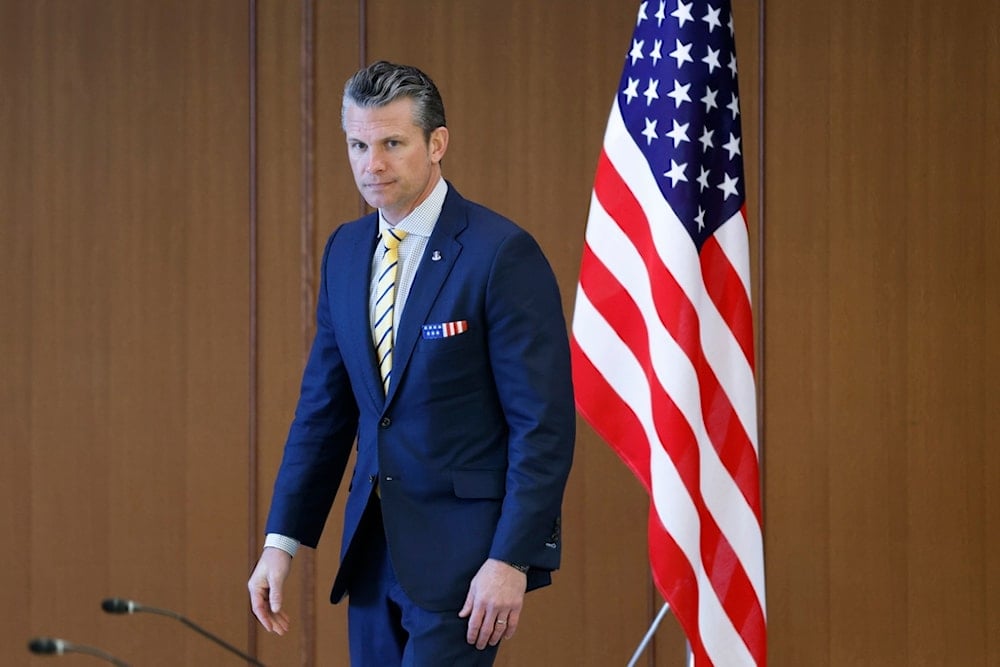Pentagon China memo has Heritage Foundation written all over it: WaPo
One of the most striking elements of the covert Pentagon memo is its apparent alignment with recommendations from the conservative Heritage Foundation.
-

US Defense Secretary Pete Hegseth attends a meeting with Japan's Defense Minister Gen Nakatani at the Ministry of Defense in Tokyo Sunday, March 30, 2025 (AP)
A secret internal guidance memo signed by Defense Secretary Pete Hegseth reveals a dramatic shift in US military priorities, focusing on deterring an alleged Chinese "takeover" of Taiwan and strengthening homeland defense, according to an exclusive report by The Washington Post.
The document, titled the Interim National Defense Strategic Guidance, was distributed within the Department of Defense in mid-March and is marked "secret/no foreign national" in most sections.
It outlines a framework for executing President Donald Trump’s strategic vision, which centers on preparing for a potential war with China and securing US interests in the "near abroad", including Greenland and the Panama Canal.
One of the most striking elements of the guidance is its apparent alignment with recommendations from the conservative Heritage Foundation, a think tank that has played a significant role in shaping Republican defense policy.
According to The Washington Post's analysis, several passages of the Pentagon memo closely mirror, and in some cases nearly duplicate, a Heritage Foundation report published in August 2024. One of the report’s co-authors, Alexander Velez-Green, is currently serving in an interim role as the Pentagon’s top policy official.
Strategic overhaul
Hegseth’s directive emphasizes that China is the US military’s "sole pacing threat," with the prevention of a "fait accompli" invasion of Taiwan as the top strategic scenario.
Unlike previous administrations that balanced threats across multiple global theaters, the new guidance instructs the Pentagon to "assume risk" in Europe, the Middle East, and elsewhere by reducing US commitments and urging allies to take on a greater share of their own defense responsibilities.
As a result, NATO is expected to shoulder a "far greater" burden in countering any Russian military actions. Meanwhile, East Asian allies will be pressed to increase defense spending against similar activity from the Democratic People's Republic of Korea (DPRK) and China.
The memo also signals a shift in priorities in West Asia and North Africa, deprioritizing groups that lack the capability or intent to launch attacks on US soil.
Political, strategic tensions
The guidance has sparked debate on Capitol Hill, where members of both parties have described it as ambiguous and contradictory. A congressional aide who reviewed the document noted inconsistencies between the administration’s rhetoric and its stated priorities, particularly in regard to military posture in the Middle East.
While the memo suggests withdrawing US forces from the region, the administration has also been actively demonstrating military strength against groups such as Ansar Allah in Yemen by carrying out flagrant aggression on the country, as well as increasing pressure on Iran.
“There’s tension between ‘We want American strength and military dominance in the world, and we want to be everywhere, but also nowhere,’” the aide said, speaking on the condition of anonymity.
The Heritage Foundation: A strong influence
Trump, as a presidential candidate, denied that Heritage’s Project 2025 plan—which outlined a far-right transition agenda across the federal government—served as a blueprint for his second term. However, his policies and appointments, including the Pentagon guidance, suggest Heritage’s influence has been significant in the first months of his administration.
Senior US military officials have directly linked Heritage’s vision to Hegseth’s guidance. Maj. Gen. Garrick Harmon, head of strategy and plans at Africa Command, recommended that his staff read the Heritage report to align their priorities with the new Pentagon directive, according to a command staff member who spoke on the condition of anonymity. Another official within Africa Command reportedly distributed a copy of the Heritage report to colleagues.
While Africa Command declined to comment on internal discussions, spokesperson Kelly Cahalan stated that the staff routinely engages with experts and reviews publicly available research. “As with all prudent military planning, we are continually leveraging the latest research to assess and develop our strategy,” she said.
Focus on Taiwan, the Indo-Pacific
Hegseth recently visited the Pacific region, emphasizing to service members in Guam that they are "the tip of the spear" for US military operations.
The Pentagon guidance calls for a “denial defense” of Taiwan, increasing US military presence through submarines, bombers, unmanned ships, and specialized Army and Marine Corps units. It also highlights the need for weapons designed to destroy reinforced and underground targets.
While underscoring deterrence against any prospective Chinese military action, the document also pressures Taiwan to "significantly increase" its defense spending. Trump and his allies have criticized Taiwan for underinvesting in its own military, urging it to allocate up to 10 percent of its GDP to defense—a figure far exceeding what the US and its allies currently spend.
In response to concerns over US commitment, Taiwan’s President Lai Ching-te recently announced an increase in defense spending to over 3% of the GDP.
US influence in Western hemisphere
Beyond Taiwan, the guidance underscores the need for the US military to defend strategic interests in the Western Hemisphere, particularly in Greenland, the Panama Canal, and Cape Horn.
Trump recently escalated tensions with Denmark by declaring, “We have to have Greenland,” reviving a long-standing geopolitical dispute.
Additionally, the document expands the military’s role in border security, drug interdiction, and deportation efforts, which are responsibilities traditionally overseen by the Department of Homeland Security—aspects previously reported by CNN and NBC News.
US commitment to NATO
The memo confirms a fundamental shift in US support for NATO, stating that the alliance must prepare to defend itself with “substantial, if any” American military assistance should Russia escalate hostilities in Europe.
The document indicates that while the US will continue to provide nuclear deterrence, conventional military forces will be allocated primarily to homeland defense and China deterrence missions.
“A significant increase in Europe sharing its defense burden,” the document states, “will also ensure NATO can reliably deter or defeat Russian aggression even if deterrence fails and the United States is already engaged in, or must withhold forces to deter, a primary conflict in another region.”
A notorious Zionist organization
A November report by Mondoweiss states that the Heritage Foundation had garnered substantial attention during this election cycle, largely due to its controversial Project 2025.
One such initiative is Project Esther, a new proposal from the Heritage Foundation that purports to address anti-Semitism in the United States.
In reality, however, the project seeks to undermine the Palestinian solidarity movement, positioning it as the first step in a wider campaign aimed at stifling activism against US policies, both domestically and internationally, according to Mondoweiss.
There is no doubt that this project is not entirely new. For over a century, the Zionist movement and the Israeli occupation have used false accusations of anti-Semitism as a weapon.
However, Project Esther came to unify and coordinate the cynical use of the fight against real anti-Semitism to completely dismantle the movement advocating for Palestinian rights.
But this is just the beginning of its agenda. As the full plan unfolds, its architects view it as a stepping stone to catalyzing broader movements aimed at challenging US imperialism abroad and white supremacy at home.
For more on Project Esther, read: Project Esther; right-wing scheme to liquidate pro-Palestine movement

 7 Min Read
7 Min Read








